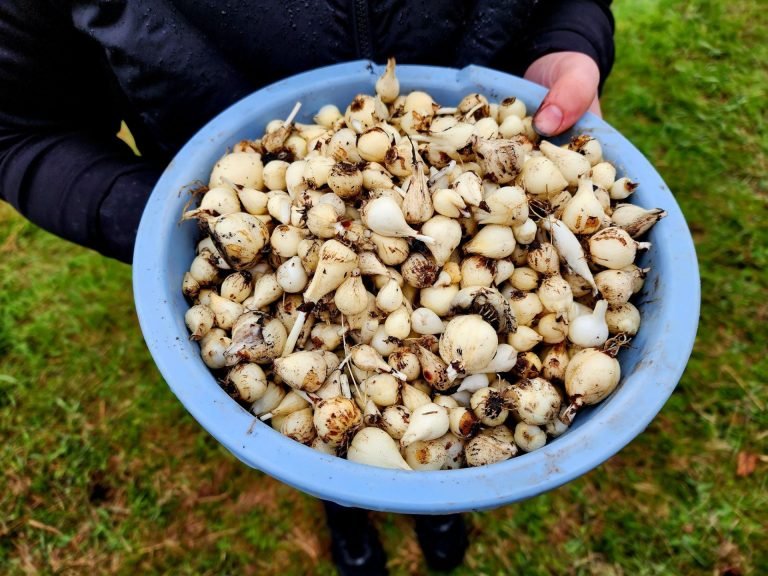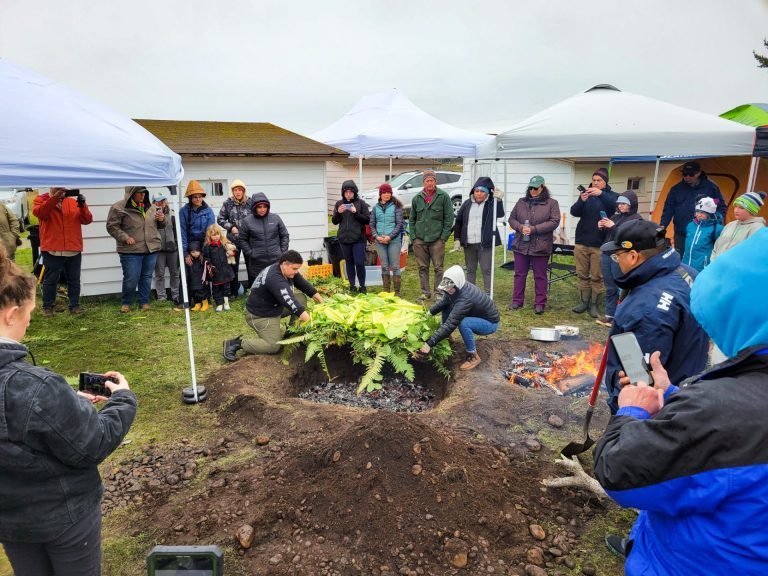This Coast Salish Food Staple is Blooming Again
Above: (Left) Camas bulbs, removed from the stalk and cleaned, resemble small onions. They taste somewhat like sticky sweet potatoes. (Right) Participants at an inter-tribal camas bake, or qwlho7el, held in April 2023 carefully lower camas bulbs tucked among layers of vegetation into a fire pit for baking. Photos: Coast Salish Youth Stewardship Corps
By Kimberly Cauvel. Originally published on Northwest Treaty Tribes News on June 30, 2023.
Lavender-colored flowers blooming across prairie landscapes were once a beacon to the region’s Indigenous people that a bounty of root vegetables awaited them beneath the soil.
This first food, called camas, is beginning to again bloom in large quantities and be shared in community meals. That’s thanks to initiatives such as the Swinomish Indian Tribal Community’s Generations Camas Project.
“We are trying to bring this back to the community because there are only a few wild plants around the reservation,” said Todd Mitchell, Swinomish tribal member and director of the tribe’s Department of Environmental Protection.
Swinomish tribal member Colin Mitchell, 17, brushes dirt from a camas bulb he pulled from the ground during a community harvest in May.
Photo: Kimberly Cauvel, Northwest Treaty Tribes
The tribe is growing camas in test plots to study how to best cultivate it, harvest it and cook it, and to reintroduce community members to it.
“It’s something that’s been lost for so long it’s like, how do you even cook it now?” Mitchell said. “What’s the conversion from a cooking pit with rock and seaweed to your oven or Crock-pot?”
The tribe has been digging into those questions since discovering camas on its homelands several years ago. Staff of the Department of Environmental Protection nurtured those plants and then started the Generations Camas Project in 2018.
Since then, several rounds of seeds have been delivered to the Skagit River System Cooperative’s plant nursery for germination. The cooperative is a collaborative natural resources organization of the Swinomish and Sauk-Suiattle tribes.
About 3,500 camas plants were brought back to the Swinomish Reservation for planting in the test plots in 2020.
With the plots awash in purple hues this May, the tribe hosted a community event to teach participants about the traditional food, the tribe’s work to revitalize it, and how to harvest it. Camas muffins made by the tribe’s camas technician Charlotte Pitt were provided as a snack.
The cream-colored bulbs anchoring the purple flowers in place are starchy and sticky, with a pear-like sweetness, Mitchell said. Sam Barr, tribal historic preservation office supervisor for the Stillaguamish Tribe of Indians and a member of the Samish Indian Nation, describes it like “a smokey, caramelized sweet potato, but really earthy.”
These earthy bulbs were a staple food item for Coast Salish people. Camas was also as valuable to Swinomish ancestors in trading as salmon, Mitchell said.
Barr, as program director of the nonprofit Coast Salish Youth Stewardship Corps, organized a camas bake this spring that drew 120 participants from tribes including Swinomish, Stillaguamish, Tulalip and others.
“For the majority of them, it was their very first time even seeing a bulb of camas, and definitely the first time tasting it traditionally cooked,” Barr said.
The group gathered on Whidbey Island in April for a multi-day event. After camas bulbs were harvested and cleaned, they were placed into a fire pit with layers of stones, skunk cabbage leaves, ferns and dirt. They were baked for 24 hours and then served alongside other foods of cultural significance.
“For some of the families it’s a neat reflection for them, to look back at their family lines and think how long it has been since their ancestors last tasted it,” Barr said. “For most, it was three or four generations.”



